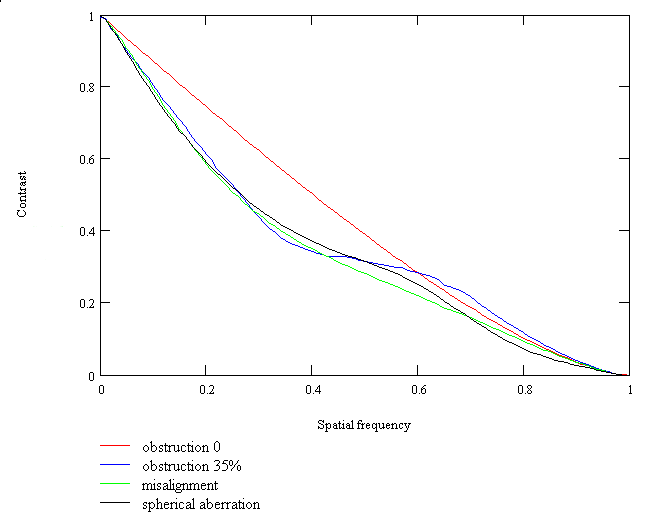
DOES THE OBSTRUCTION
HAVE LESS
EFFECTS IN CCD THAN IN VISUAL ?
We sometimes hear that in CCD the optics have less importance, and in particular that the effects of the central obstruction of telescopes are far less "devastating" in digital imaging than in visual observation. Are there objective elements that can support this opinion?
The influence of obstruction (see What are the effects of obstruction?) can be summarized to a drop of contrast of the image in low and medium spatial frequencies. One can therefore consider it as an optical aberration in the same capacity as spherical aberration, misalignment or even a focus defect : all are wavefront degradations that cause a drop of contrast. Besides, it is interesting to notice that, as shown in the following MTF curve (see What is a MTF curve?), the influence of these different aberrations is quite similar. In particular, all show a general drop of contrast from the lowest frequencies. A simulation of atmospheric turbulence (see the book Star Testing Astronomical Telescopes) also show a quite similar drop of contrast.

Practice of CCD (or webcam) imaging has since a long time demonstrated the visible and irreparable effects of misalignment, strong spherical aberration or bad seeing on the quality of digital images as well as in visual observation. The most famous example is perhaps the Hubble Space Telescope that originally suffered from a strong spherical aberration whose consequence on its CCD images was disastrous since these images showed performances inferior to those of a good 16" telescope, although the optics of the HST have a diameter of 96" (it is coherent with the MTF curve of the original optics of the HST that show a drop of contrast in low and medium frequencies of about 6 times).
Everyone who practices planetary imaging knows that a CCD
image is something fragile, taken in difficult conditions (low light,
turbulence...) and where information is always ready to disappear before the
least problem. It doesn't matter that a drop of contrast is due to a cause or
another, it is still a drop of contrast and its effects are still the same: the subtle
details disappear or vanish in the noise of the image. While all aberrations
have visible effects, by which miracle the obstruction, and only it, could
distinguish itself by negligible effects in digital imaging?
Image processing is indeed able to increase the contrast of a digital image but
this manipulation presents strong limitations due to noise. Moreover, an
increase of the contrast can be applied as well on an image taken with a low
obstruction and an image taken with a higher obstruction: if there is a large
difference of quality between both images before processing, the difference will
remain of course after processing!
The is no objective reason to claim that the obstruction has less important effects in CCD. On the contrary, everything tends to prove that its effects can be felt in CCD as well as in visual observation. By way of consequence, the underlying claim that instruments obstructed at about 35% would present visual performances extremely damaged by their obstruction while being able of excellent CCD images is, as well, an idée reçue.